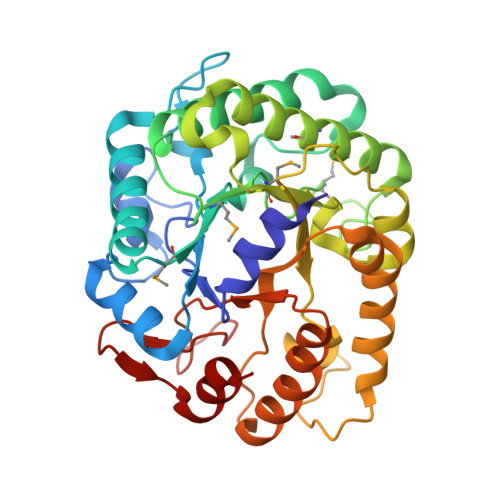Structural Basis for Xyloglucan Specificity and alpha-d-Xylp(1 6)-d-Glcp Recognition at the -1 Subsite within the GH5 Family.
Dos Santos, C.R., Cordeiro, R.L., Wong, D.W., Murakami, M.T.(2015) Biochemistry 54: 1930-1942
- PubMed: 25714929
- DOI: https://doi.org/10.1021/acs.biochem.5b00011
- Primary Citation of Related Structures:
4W84, 4W85, 4W86, 4W87, 4W88, 4W89, 4W8A, 4W8B - PubMed Abstract:
GH5 is one of the largest glycoside hydrolase families, comprising at least 20 distinct activities within a common structural scaffold. However, the molecular basis for the functional differentiation among GH5 members is still not fully understood, principally for xyloglucan specificity. In this work, we elucidated the crystal structures of two novel GH5 xyloglucanases (XEGs) retrieved from a rumen microflora metagenomic library, in the native state and in complex with xyloglucan-derived oligosaccharides. These results provided insights into the structural determinants that differentiate GH5 XEGs from parental cellulases and a new mode of action within the GH5 family related to structural adaptations in the -1 subsite. The oligosaccharide found in the XEG5A complex, permitted the mapping, for the first time, of the positive subsites of a GH5 XEG, revealing the importance of the pocket-like topology of the +1 subsite in conferring the ability of some GH5 enzymes to attack xyloglucan. Complementarily, the XEG5B complex covered the negative subsites, completing the subsite mapping of GH5 XEGs at high resolution. Interestingly, XEG5B is, to date, the only GH5 member able to cleave XXXG into XX and XG, and in the light of these results, we propose that a modification in the -1 subsite enables the accommodation of a xylosyl side chain at this position. The stereochemical compatibility of the -1 subsite with a xylosyl moiety was also reported for other structurally nonrelated XEGs belonging to the GH74 family, indicating it to be an essential attribute for this mode of action.
Organizational Affiliation:
†Brazilian Biosciences National Laboratory, National Center of Research in Energy and Materials, Campinas, São Paulo 13083-970, Brazil.


















